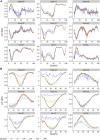Smooth and accurate predictions of joint contact force time-series in gait using over parameterised deep neural networks
- PMID: 37465692
- PMCID: PMC10350628
- DOI: 10.3389/fbioe.2023.1208711
Smooth and accurate predictions of joint contact force time-series in gait using over parameterised deep neural networks
Abstract
Alterations in joint contact forces (JCFs) are thought to be important mechanisms for the onset and progression of many musculoskeletal and orthopaedic pain disorders. Computational approaches to JCFs assessment represent the only non-invasive means of estimating in-vivo forces; but this cannot be undertaken in free-living environments. Here, we used deep neural networks to train models to predict JCFs, using only joint angles as predictors. Our neural network models were generally able to predict JCFs with errors within published minimal detectable change values. The errors ranged from the lowest value of 0.03 bodyweight (BW) (ankle medial-lateral JCF in walking) to a maximum of 0.65BW (knee VT JCF in running). Interestingly, we also found that over parametrised neural networks by training on longer epochs (>100) resulted in better and smoother waveform predictions. Our methods for predicting JCFs using only joint kinematics hold a lot of promise in allowing clinicians and coaches to continuously monitor tissue loading in free-living environments.
Keywords: deep learning; locomotion; machine learning; musculoskeletal modelling; running biomechanics; walking biomechanics.
Copyright © 2023 Liew, Rügamer, Mei, Altai, Zhu, Zhai and Cortes.
Conflict of interest statement
The authors declare that the research was conducted in the absence of any commercial or financial relationships that could be construed as a potential conflict of interest.
Figures







Similar articles
-
Evaluation of the accuracy of musculoskeletal simulation during squats by means of instrumented knee prostheses.Med Eng Phys. 2018 Nov;61:95-99. doi: 10.1016/j.medengphy.2018.09.004. Epub 2018 Sep 30. Med Eng Phys. 2018. PMID: 30282587
-
Linking Joint Impairment and Gait Biomechanics in Patients with Juvenile Idiopathic Arthritis.Ann Biomed Eng. 2019 Nov;47(11):2155-2167. doi: 10.1007/s10439-019-02287-0. Epub 2019 May 20. Ann Biomed Eng. 2019. PMID: 31111329 Free PMC article.
-
Ankle joint contact force profiles differ between those with and without chronic ankle instability during walking.Gait Posture. 2023 Feb;100:1-7. doi: 10.1016/j.gaitpost.2022.11.012. Epub 2022 Nov 25. Gait Posture. 2023. PMID: 36459912
-
Contributions to the understanding of gait control.Dan Med J. 2014 Apr;61(4):B4823. Dan Med J. 2014. PMID: 24814597 Review.
-
Foot and ankle biomechanics in walking and running. A review.Am J Phys Med Rehabil. 1988 Dec;67(6):246-52. Am J Phys Med Rehabil. 1988. PMID: 3058153 Review.
Cited by
-
Walking and scuba diving assisted amphibious exoskeleton robots: the designing of power assist control and myoelectricity based wearers' fatigue evaluation.Front Neurosci. 2024 Sep 27;18:1472184. doi: 10.3389/fnins.2024.1472184. eCollection 2024. Front Neurosci. 2024. PMID: 39399383 Free PMC article.
-
Towards a comprehensive biomechanical assessment of the elderly combining in vivo data and in silico methods.Front Bioeng Biotechnol. 2024 May 6;12:1356417. doi: 10.3389/fbioe.2024.1356417. eCollection 2024. Front Bioeng Biotechnol. 2024. PMID: 38770274 Free PMC article.
-
Intelligent prediction of lower extremity loadings during badminton lunge footwork in a lab-simulated court.Front Bioeng Biotechnol. 2023 Aug 8;11:1229574. doi: 10.3389/fbioe.2023.1229574. eCollection 2023. Front Bioeng Biotechnol. 2023. PMID: 37614628 Free PMC article.
-
Performance of multiple neural networks in predicting lower limb joint moments using wearable sensors.Front Bioeng Biotechnol. 2023 Jul 31;11:1215770. doi: 10.3389/fbioe.2023.1215770. eCollection 2023. Front Bioeng Biotechnol. 2023. PMID: 37583712 Free PMC article.
References
-
- Ardestani M. M., Chen Z., Wang L., Lian Q., Liu Y., He J., et al. (2014). Feed forward artificial neural network to predict contact force at medial knee joint: Application to gait modification. Neurocomputing 139, 114–129. 10.1016/j.neucom.2014.02.054 - DOI
-
- Boswell M. A., Uhlrich S. D., Kidziński Ł., Thomas K., Kolesar J. A., Gold G. E., et al. (2021). A neural network to predict the knee adduction moment in patients with osteoarthritis using anatomical landmarks obtainable from 2d video analysis. Osteoarthr. Cartil. 29, 346–356. 10.1016/j.joca.2020.12.017 - DOI - PMC - PubMed
LinkOut - more resources
Full Text Sources

